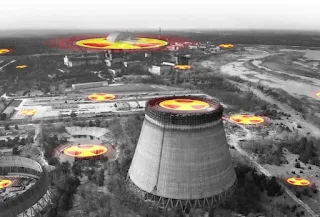Because of Russia's war on Ukraine, will Chernobyl cause a new nuclear disaster?
Given the legacy of Chernobyl, one would think that Russia would avoid attacks on operating reactors, especially as it would be a victim of radioactive particles that would be carried by the wind.
With the beginning of the Russian invasion of Ukraine, an increase in the level of radiation was recorded around the Chernobyl reactor, and fears surfaced that the Ukrainian nuclear reactors would be exposed to damage that would lead to rumors leaking from them. What is the probability of these risks occurring? What are the repercussions if they occur?
Although Ukraine does not currently have nuclear weapons, it has on its territory 15 nuclear power reactors in 4 plants that generate approximately 50% of its energy needs in 4 sites.
The most famous of these facilities is the Chernobyl nuclear power plant, in which the explosion of one of its reactors in 1986 released clouds of radioactive material over the surrounding area, in an incident described as the worst of its kind in the 20th century.
High level of radiation
Russian forces took control of Chernobyl and its power plant on Thursday, February 24, after clashes near the site's nuclear waste depot.
Data from radiation monitoring systems in the region showed an increase in the level of gamma radiation about 20 times over the usual levels at multiple observation points, according to a report published on the "Live Science" website.
On the other hand, a statement published by the International Atomic Energy Agency stated that it had been informed that an electrical transformer at the low-level radioactive waste disposal site had been damaged, but without the release of radioactive materials near the city of Kharkiv (north-eastern Ukraine).
These data have raised the concern of the international community, especially with news that the Russian forces have held the task force tasked with monitoring radiation levels and keeping them within safe limits hostage by Russian forces, according to Ukrainian sources.
Although officials from the Ukrainian Nuclear Agency attributed the reasons for this rise to radioactive dust caused by the movement of heavy military equipment in the region, the risk of direct injury - intended or unintended - to nuclear plants in the midst of this conflict seems likely, according to experts.
Potential risks
Power plants are common targets in modern armed conflicts, according to Bennett Ramberg, a former US officer and author of "Nuclear Power Plants as Weapons for the Enemy," because their destruction impedes a country's ability to continue fighting.
But nuclear reactors are not like other energy sources, and they may turn into a frightening ghost if they are hit, because they contain huge amounts of radioactive materials.
These radiations can be released - according to an article published by the American expert on the “Project Syndicate” website - as a result of a bombing that damages the reactor building or cuts off the vital cooling lines that maintain its stability, and serious damage can be caused to the station through an electronic attack or cut off external power. on which nuclear plants depend to keep them running.
According to Dr. Lydia Zablotska, Professor of Epidemiology and Public Health at the University of California, San Francisco, in a statement to People, any damage to the Chernobyl plant will have serious repercussions, especially that “the sarcophagus that was built in 2017 to surround the nuclear reactors and provide A shield covering the radioactive materials stored at the site is nearing its lifespan, and it was scheduled to be demolished by 2023, and the filling of the storage site inside the barrels to contain the radioactive materials began only about a year ago.”
Russia will also be a victim
According to experts, the health consequences of such accidents depend on the number of exposed populations and the toxicity of the radioactive elements. The true cost of the 1986 disaster is still unknown, with reports estimating the true number of casualties at between 4,000 and 90,000 although the immediate death toll officially did not exceed 31.
"If there was an explosion at that location and the radioactive particles were released into the atmosphere, they would be dispersed by the prevailing winds," Zablotska says.
"This is what happened in 1986 when the wind was blowing in the northwest direction, causing it to spread throughout northern Europe," Zablotska adds.
So far, it seems that Ukraine's nuclear facilities have not yet been exposed to a great danger, according to the International Atomic Energy Agency, which stated in its statement issued on February 26 that Ukraine had informed it that the country's nuclear power plants are still stable and operating normally, and that the staff of the Inspectorate The state nuclear energy regulator maintained regular contacts with the plants.
Given Chernobyl's legacy, one would think that Russia would avoid attacks on operating reactors, especially as it would be a victim of radioactive particles that would be carried by the wind, says Ramberg.
Tags:
awakening conscience
cambridge science
electrical sciences
genomic sciences
geo science
life science
live science
neuroscience
science
science magazine
space science

